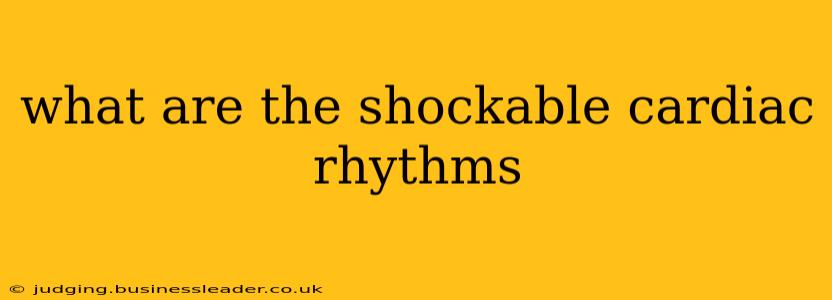What Are the Shockable Cardiac Rhythms?
Understanding shockable cardiac rhythms is crucial in emergency situations. Defibrillation, a life-saving procedure that delivers a controlled electric shock to the heart, is only effective on certain arrhythmias. Knowing which rhythms are shockable and which are not is vital for paramedics, emergency medical technicians (EMTs), and even laypeople trained in cardiopulmonary resuscitation (CPR). This article will detail the shockable rhythms, explain why they're shockable, and touch upon some frequently asked questions.
What is Defibrillation and Why Does it Work on Certain Rhythms?
Defibrillation works by depolarizing a large mass of heart muscle cells simultaneously. This depolarization aims to interrupt the chaotic electrical activity causing the abnormal rhythm and allow the heart's natural pacemaker (the sinoatrial node) to resume its normal function. This is effective only on rhythms characterized by disorganized electrical activity that prevents effective contraction of the heart, leading to cardiac arrest. It doesn't work on rhythms that have some organized electrical activity, even if that activity is slow or inefficient.
What Are the Main Shockable Rhythms?
The two main shockable rhythms are:
-
Ventricular Fibrillation (VF): VF is a chaotic, disorganized rhythm where the ventricles quiver ineffectively instead of pumping blood. The ECG shows irregular, wavy lines without identifiable P waves, QRS complexes, or T waves. The heart is essentially "fluttering" and unable to circulate blood. This is a life-threatening emergency.
-
Pulseless Ventricular Tachycardia (pVT): pVT is a rapid heart rhythm originating in the ventricles. While there's organized electrical activity, the heart rate is so fast that the ventricles don't have enough time to fill with blood adequately before contracting, resulting in no effective blood flow. The ECG shows rapid, wide QRS complexes without discernible P waves. The absence of a palpable pulse is critical in defining this as "pulseless" VT; a pulse present indicates a different treatment strategy.
Are there any other rhythms that might be considered shockable?
While VF and pVT are the primary shockable rhythms, there are situations where other rhythms might warrant consideration. This usually involves clinical judgment and advanced assessment by healthcare professionals. These situations are beyond the scope of basic life support and often involve sophisticated monitoring and analysis. For instance, some forms of extremely rapid organized rhythms might be considered for defibrillation in certain circumstances but require specialized medical expertise.
What Rhythms are NOT Shockable?
Several rhythms are not shockable because defibrillation would be ineffective or even harmful. These include:
- Asystole (flatline): Asystole represents the complete absence of electrical activity in the heart. Defibrillation is futile as there are no electrical impulses to interrupt.
- Pulseless Electrical Activity (PEA): PEA indicates organized electrical activity but no mechanical contraction (no pulse). The electrical activity is not chaotic enough to benefit from defibrillation.
- Organized Tachycardia with a Pulse: While fast, organized rhythms can cause hemodynamic compromise, defibrillation is contraindicated because it could trigger VF.
How is the Rhythm Identified?
Identifying shockable rhythms requires the use of an electrocardiogram (ECG) monitor. In emergency settings, paramedics and EMTs use portable ECG machines to quickly determine the rhythm and guide treatment decisions. Laypersons using Automated External Defibrillators (AEDs) will receive audio-visual prompts from the device that will guide them regarding whether or not a shock is advised.
What Happens After Defibrillation?
After a shock is delivered, CPR is immediately resumed. The rhythm is reassessed immediately following the shock and further defibrillations or other advanced life support interventions may be required.
This information is for educational purposes only and does not constitute medical advice. Always seek the advice of a qualified healthcare professional for any questions you may have regarding your health or treatment. Proper training is essential for anyone administering defibrillation.
